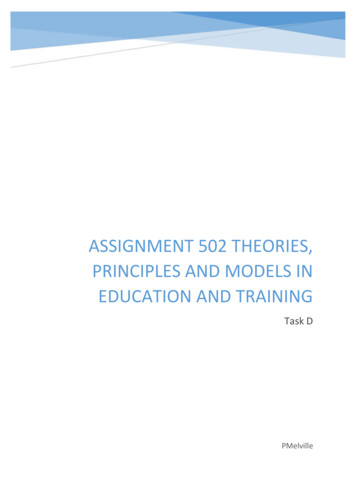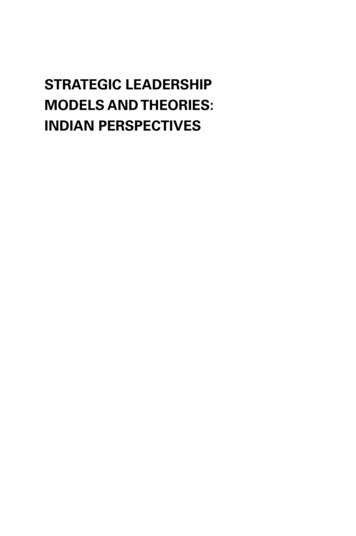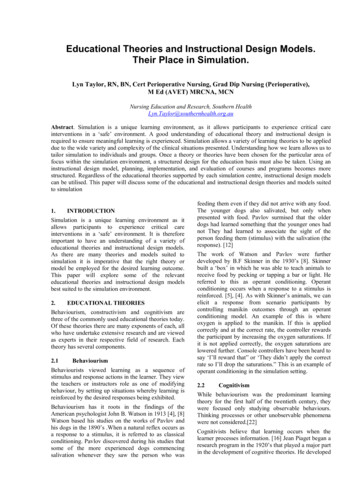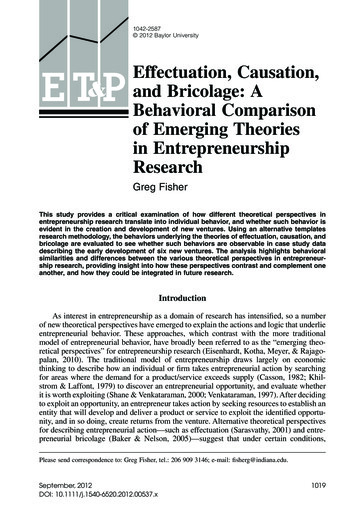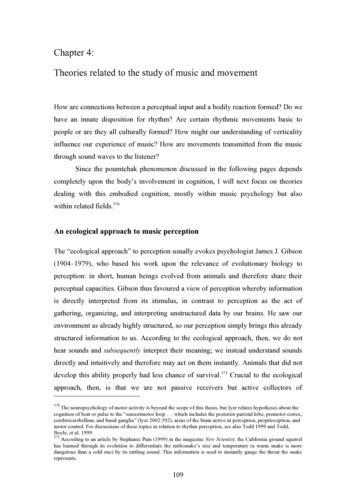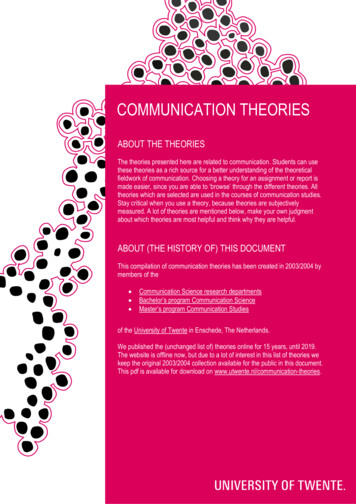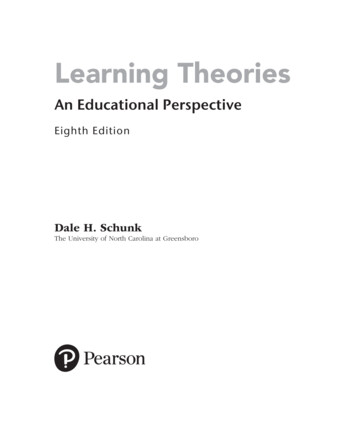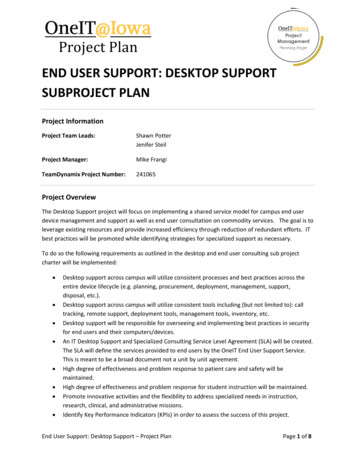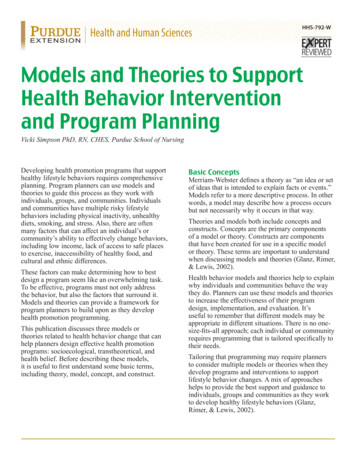
Transcription
Health and Human SciencesHHS-792-WModels and Theories to SupportHealth Behavior Interventionand Program PlanningVicki Simpson PhD, RN, CHES, Purdue School of NursingDeveloping health promotion programs that supporthealthy lifestyle behaviors requires comprehensiveplanning. Program planners can use models andtheories to guide this process as they work withindividuals, groups, and communities. Individualsand communities have multiple risky lifestylebehaviors including physical inactivity, unhealthydiets, smoking, and stress. Also, there are oftenmany factors that can affect an individual’s orcommunity’s ability to effectively change behaviors,including low income, lack of access to safe placesto exercise, inaccessibility of healthy food, andcultural and ethnic differences.These factors can make determining how to bestdesign a program seem like an overwhelming task.To be effective, programs must not only addressthe behavior, but also the factors that surround it.Models and theories can provide a framework forprogram planners to build upon as they develophealth promotion programming.This publication discusses three models ortheories related to health behavior change that canhelp planners design effective health promotionprograms: socioecological, transtheoretical, andhealth belief. Before describing these models,it is useful to first understand some basic terms,including theory, model, concept, and construct.Basic ConceptsMerriam-Webster defines a theory as “an idea or setof ideas that is intended to explain facts or events.”Models refer to a more descriptive process. In otherwords, a model may describe how a process occursbut not necessarily why it occurs in that way.Theories and models both include concepts andconstructs. Concepts are the primary componentsof a model or theory. Constructs are componentsthat have been created for use in a specific modelor theory. These terms are important to understandwhen discussing models and theories (Glanz, Rimer,& Lewis, 2002).Health behavior models and theories help to explainwhy individuals and communities behave the waythey do. Planners can use these models and theoriesto increase the effectiveness of their programdesign, implementation, and evaluation. It’suseful to remember that different models may beappropriate in different situations. There is no onesize-fits-all approach; each individual or communityrequires programming that is tailored specifically totheir needs.Tailoring that programming may require plannersto consider multiple models or theories when theydevelop programs and interventions to supportlifestyle behavior changes. A mix of approacheshelps to provide the best support and guidance toindividuals, groups and communities as they workto develop healthy lifestyle behaviors (Glanz,Rimer, & Lewis, 2002).
organized social institutions. These institutionshave formal or informal policies and structures.Socioecological ModelThe first model, the socioecological model,addresses behavior change at multiple levels andconsiders the inter-relationship between behaviorand the environment. The model accounts formultiple factors that can influence the behaviorchange process.4. Community factors — these describethe relationships among organizations andinstitutions. This includes community norms.5. Public policies — these refer to policies orregulations concerning healthy practices.The model identifies five levels of influence onhealth behavior and discusses the reciprocalrelationship between them (Stokols, 1996;McLeroy, Bibeau, Steckler, & Glanz, 1988):In the socioecological model, an individual’sbehavior influences and is influenced by factors inthe other levels (Glanz, Rimer, & Lewis, 2002).Using this model allows a program planner toconsider factors from multiple levels that canimpact health.1 . Intrapersonal factors — these includeindividual characteristics such as knowledge,beliefs, and self-concept. Most health promotionprogramming is aimed at this level.For example, to develop programming for adultobesity, a planner must first understand thepolicies, structures, behaviors, and norms thatsupport obesity in the community. Communitiesthat do not have access to healthy food orlow-cost exercise options will have difficultysupporting an individual who attempts to becomehealthier. While individual lifestyle factors areimportant to consider, this model encouragesthe planner to identify interventions to influencefactors where individuals live, work, and play. SeeFigure 1.2. Interpersonal processes and primarygroups — these include the individual’s socialenvironment such as family, friends, peers,and co-workers that surround the individualand influence behavior. In turn, an individual’sbehavior also influences family, friends, andpeers (National Cancer Institute [NCI], 2005).3. Institutional or organizational factors —these refer to workplaces, churches, and otherIntrapersonalFactors Educate communities aboutstrategies to decrease obesity Encourage counseling toincrease self-confidenceInterpersonal Encourage individualsto exercise with peers Offer communitywalking groupsInstitutionalCommunity Encourage workplaces to Develop social mediaprovide environments that campaigns with healthmessagessupport health with fitness Work with communitiesfacilities, healthy foodto provide healthyoptionsfood optionsPublic Advocate for legislationthat supports healthypolicies Apply for funding toaddress obesityFigure 1. A socioecological approach to obesity. This figure shows interventions that program planners can take at each level of thesocioecological model to implement a health program that targets obesity.2
It is important to be aware that this process canbe cyclical. Individuals may start at one stageand progress forward, or may go backward. Themodel includes several other important conceptsthat help describe factors or activities that occuras individuals attempt to make a behavior change.These include weighing the benefits and costsof making a change, evaluating the impact ofthe change, finding support for the change, anddetermining whether or not they can confidentlymake the change to a healthy behavior (Glanz,Rimer, & Lewis, 2002; NCI, 2005).Transtheoretical Model (Stages of Change)The transtheoretical model describes the process ofbehavior change and accounts for an individual’sreadiness to make and sustain behavior changes.This model is useful because it helps plannersdesign programs based on an individual’s readiness,motivation, and ability.The model includes five stages (Glanz, Rimer, &Lewis, 2002; NCI, 2005):1. Precontemplation — in this stage, theindividual has no intention to change behaviorwithin the next six months. The individual maylack knowledge or may have been unsuccessfulwith previous attempts at a change.While there are some similarities to thesocioecological model, this model focuses onhelping the individual to move through the stagestoward a sustained behavior change.2. Contemplation — in this stage, an individual isconsidering a behavior change within the nextsix months. Ambivalence, however, may keepthe individual from progressing to the next stage.For example, if a program planner uses thetranstheoretical model to address obesity, then theplanner must determine the individual’s currentstage of change in relation to lifestyle behaviorsthat lead to obesity. In most cases, severalbehaviors contribute to obesity. Figure 2 showsinterventions using this model to address physicalinactivity as a contributor to obesity. Theseinterventions are tailored specifically to each stagewith the hope that the individual will respond bymoving forward in the behavior change processdescribed by this model.3. Preparation — in this stage, the individual takessome steps toward making a change and doingso within the next 30 days.4. Action — an individual reaches this stage oncehe or she has made an apparent behavior changefor six months or less.5. Maintenance — if the individual’s behaviorchange lasts for more than six months, he or shemoves into the final stage, maintenance.Maintenance Encourage individuals toexpand their physical Help the individual identify activity options and toPreparationstrategies to maintain Support any increases insupport others who mayContemplationphysical activity. Help find physical activity, addressbe considering a behavior Help the individual identify potential resources tobarriers, and set goals.change.Precontemplation barriers to physicalSupport confidence tosupport exercise, such as Educate the individual about activity and encouragemaintain the change.peer support systems,obesity and the role exercise them to develop exercisereminder cues, rewards.plans.plays, including pros andcons of the change.ActionFigure 2. A transtheoretical model approach to physical inactivity. This figure shows interventions that program planners can implement at eachstage to support an individual’s behavior change related to physical activity.3
that spur individuals toward action. For example anindividual may see a television ad featuring a wellknown actor discussing weight-loss strategies.Health Belief ModelThe health belief model is one of the oldest modelsof health behavior, but is still very relevant whendiscussing health behavior change. This modeladdresses the readiness to act upon a healthbehavior based upon several individual beliefs.These beliefs include:Self-efficacy refers to an individual’s confidencethat he or she can successfully carry out theindicated actions. If individuals do not believe theycan successfully make a behavior change, they areunlikely to do so (Rimer, Glanz, & Lewis, 2002;NCI, 2005).1. Perceived susceptibility — refers to beliefsconcerning risk or susceptibility to a condition ordisease.This model can be very useful in designing healthpromotion programming. For example, mostindividuals are very aware that obesity often leadsto the development of diabetes. Figure 3 shows howplanners can use the health belief model to developinterventions to address obesity to avoid diabetes.In this example, the interventions are aimed ateducating individuals to increase their perceivedsusceptibility to and seriousness of diabetes as anoutcome of obesity.2. Perceived severity — refers to beliefs concerningthe possible severity of a disease or condition.3. Perceived benefits — refers to the perceivedvalue or benefit of behavior changes in reducingthe risk of a condition or disease.4. Perceived barriers — refers to any obstacles orbarriers to the behavior changes being consideredto decrease risk.Education also helps individuals discover thebenefits of decreasing their risk of diabetes bylosing weight. Helping individuals to identifyand eliminate barriers may help them see that thebenefits outweigh the barriers, thus encouragingactions to avoid the development of diabetes bydealing with their obesity.If individuals perceive they are susceptible to acondition (1) and that the condition could be severe(2), they will most likely take action to avoid thecondition. The likelihood of action is enhanced ifthe perceived benefits (3) outweigh the perceivedbarriers (4).The model also includes two other constructs: cuesto action and self-efficacy. Cues to action are events Educate individualsconcerning obesity as arisk factor for erceivedBenefitsPerceivedBarriers Educate individuals about thebenefits of increased physicalactivity and healthy diets inreducing the potential risk for diabetes. Discuss the potential effectsof diabetes managementor complications on theindividual’s quality of life. Encourage individuals todiscuss potential barriers suchas lack of access to exercisefacilities, healthy foods, etc.Figure 3. A health belief model approach to addressing obesity as a factor in diabetes. This figure shows interventions that program planners canuse to help individuals change their behaviors to avoid the risk of diabetes.4
SummaryEach model reflects different, yet related,dimensions of the behavior change process.Determining which model to use will depend uponthe situation. In many cases, planners may find thatusing more than one model is appropriate or thatonly certain aspects of a model are useful.ReferencesGlanz, K., B. Rimer, , & F. Lewis. (2002). Healthbehavior and health education. San Francisco,CA: John Wiley & Sons, Inc.National Cancer Institute (2005). Theory at a glanceguide for health promotion practice.McLeroy, K. R., D. Bibeau, A. Steckler, & K.Glanz. (1988). An ecological perspective onhealth promotion programs. Health Education &Behavior, 15(4), 351-377.Consider a program planner who is working with anobese individual whose family members seem to beable to eat whatever they want without developingdiabetes. In such instances, the health belief modelmay be useful. In this example, the planner mayneed to enhance the interventions for perceivedsusceptibility.Stokols, D. (1996). Translating social ecologicaltheory into guidelines for community healthpromotion. American Journal of HealthPromotion, 10(4), 282-298.If an educator is working with a group oflow-income individuals who are dealing withobesity and work for the same employer, thesocioecological model may be more useful. Theplanner may need to aim more effort to createand support healthy work environments and findresources that provide low-income individualsopportunities for exercise and healthy food options.Theory [Def. 1.]. (n.d.). Merriam Webster Online.In Merriam Webster online. Retrieved October26, 2014, from www.merriam-webster.com/dictionary/theory.In both of these examples, the transtheoreticalmodel may help an educator determine whatinterventions are appropriate to move both groupsalong the continuum toward behavior change.Models and theories can help us understandbehavior and plan health promotion programming.They also can remind us to consider and addressthe many variables and factors that affect thebehavior change process at the individual, group,and community levels. The three models discussedin this publication are among the most commonlyused. However, there are many more models andtheories that explain. The availability of multiplemodels and theories allows the program plannerto support design of effective health promotionprograms.Mar 2015It is the policy of the Purdue University Cooperative Extension Service that all persons have equal opportunity and access to its educational programs, services, activities, and facilitieswithout regard to race, religion, color, sex, age, national origin or ancestry, marital status, parental status, sexual orientation, disability or status as a veteran.Purdue University is an Affirmative Action institution. This material may be available in alternative formats.1-888-EXT-INFO www.extension.purdue.eduOrder or download materials fromPurdue Extension The Education Storewww.edustore.purdue.edu
program planners to build upon as they develop health promotion programming. This publication discusses three models or . theories related to health behavior change that can help planners design effective health promotion programs: socioecological, transtheore
